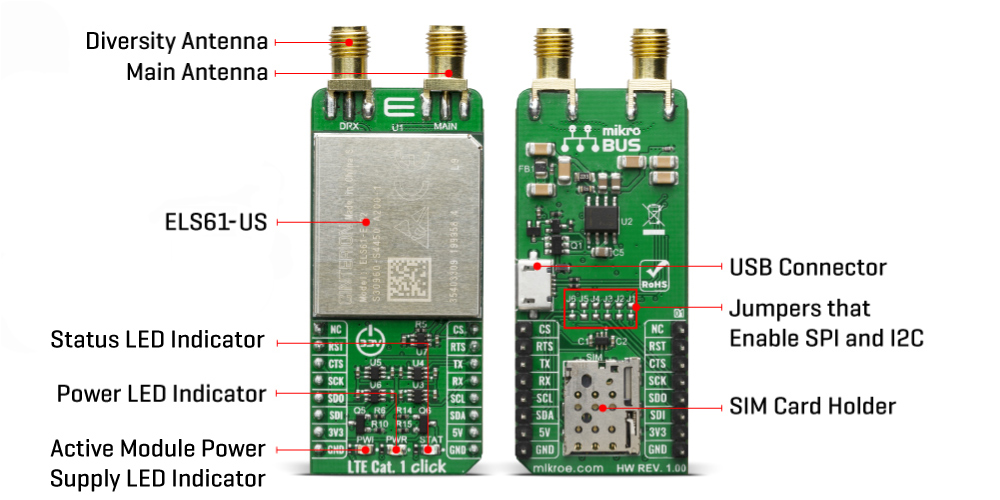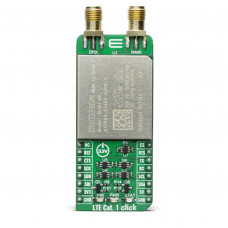LTE Cat.1-US Click (for United States)
LTE Cat.1-US Click is a compact add-on board containing a low-power LTE-IoT connectivity solution. This board features the ELS61 (ELS61-US), a multi-band wireless module from Thales. The ELS61-US delivers highly efficient Cat 1 LTE connectivity for M2M IoT solutions offering seamless fallback to 2G and 3G networks. The best in the class solution enables M2M optimized speeds of 10Mbit/s download and 5Mbit/s uplink, making it ideal for many M2M and industrial IoT applications. These applications are not dependent on speed but require the longevity of LTE networks while still providing 3G and 2G connectivity to ensure total population and geographic coverage as LTE rolls out.
LTE Cat.1-US Click is supported by a mikroSDK compliant library, which includes functions that simplify software development. This Click board™ comes as a fully tested product, ready to be used on a system equipped with the mikroBUS™ socket.
NOTE: It is necessary to emphasize that Voice over LTE feature (VoLTE) is supported only on ELS61-USA (AT&T, VoLTE, and CSFB) and ELS61-E (CSFB) wireless modules. Special note for the 4G network: Before buying this product, be sure to check if the modules' LTE bands match the 4G capabilities in your country.
LTE Cat.1-US Click as its foundation uses the ELS61, a multi-band wireless module from Thales. There are two Click boards™ to cover two different regions: LTE Cat.1-EU Click for the Europe region, which features the ELS61-E module, and the LTE Cat.1-US click for the North American region, which features the ELS61-US module. The main difference between these two modules is the supported frequency bands, compliant with the regulations for each region. A complete list of supported bands for each module, along with other relevant info about the module itself, can be found in the attached ELS61 datasheet.

The ELS61-US module featured on LTE Cat.1-US Click comes with a Java® embedded virtual machine leveraging a robust ARM11 architecture that allows device manufacturers to utilize the massive to reduce complexity and speed application integration. The latest Java ME 3.2 client runtime platform reduces total cost of ownership (TCO) and time to market by sharing internal resources such as memory, a large existing codebase, and proven software building blocks. The module uses Multi MIDlet Java execution to host and run multiple applications and protocols simultaneously.
The UART bus of the ELS61-US series module is connected to one side of the level shifter, while the other side (shifted) is connected to the respective mikroBUS™ UART pins. However, the ELS61 series module is designed as the traditional DCE device (Data Communication Equipment) offering the full UART pin count, including the hardware flow control pins (CTS, RTS). These pins are routed to the mikroBUS™ CS (CTS) and the INT pin (RTS) and can be used in the MCU software if the hardware flow control is needed.
An extended security concept with the latest TLS/SSL engine provides secure and reliable TCP/IP connectivity. Its sophisticated sandbox modeling and layered architectures simplify device management and allow simultaneous progress of network operator approvals and application code development for a shorter time to market. The LTE Cat.1 module delivers long product lifespans up to seven years, efficient bandwidth and power utilization plus a feature set that meets the rigorous requirements of M2M IoT solutions including extended operating temperatures from -40°C to 85°C.
The LTE Cat.1-US Click ensures easy integration and a fast time to market for innovative solutions, and it also provides a dependable connectivity platform with the support needed for a fast time to market and a value you can trust.
Given all the possibilities these features offer, the LTE Cat.1-US Click can be used for various applications such as metering, tracking and tracing, remote surveillance, connected signs, fleet management and mHealth.
Specifications:
| Type | 2G GPRS,3G UMTS,4G LTE,GSM/LTE |
| Applications | Metering, tracking and tracing, remote surveillance, connected signs, fleet management and mHealth |
| On-board modules | ELS61-US - multi-band wireless module from Thales |
| Radio Region | America |
| Key Features | Data rates of up to 10.2 Mb/s for download and up to 5.2 Mb/s for upload, real time clock with alarm functionality |
| Interface | GPIO,I2C,SPI,USB |
| Compatibility | mikroBUS |
| Click board size | L (57.15 x 25.4 mm) |
| Input Voltage | 3.3V,5V |
PinOut Diagram:
This table shows how the pinout on LTE Cat.1-US Click corresponds to the pinout on the mikroBUS™ socket (the latter shown in the two middle columns).
OnBoard Settings And Indicators:
| Label | Name | Default | Description |
|---|---|---|---|
| LD1 | PWR | - | Power LED Indicator |
| LD2 | PWI | - | Power indication LED |
| LD3 | STAT | - | Status LED Indicator |
| J1 | J1 | Unpopulated | CS Enable/Disable Jumper |
| J2 | J2 | Unpopulated | SCK Enable/Disable Jumper |
| J3 | J3 | Unpopulated | MISO Enable/Disable Jumper |
| J4 | J4 | Unpopulated | MOSI Enable/Disable Jumper |
| J5 | J5 | Unpopulated | SCL Enable/Disable Jumper |
| J6 | J6 | Unpopulated | SDA Enable/Disable Jumper |
NOTE: Pins for SPI and I2C are not connected by default on mikroBUS™ since module is always acting as master which is not allowed for Click board™, but can be enabled by adding 0 ohm resistors to jumpers from J1 to J6 on the back side.
Software Support:
We provide a library for the LTE Cat.1 Click on our LibStock page, as well as a demo application (example), developed using MikroElektronika compilers. The demo can run on all the main MikroElektronika development boards.
Library Description
The library covers all the necessary functions to control LTE Cat.1 Click board™. Library carries generic command parser adopted for AT command based modules.
Key functions:
void ltecat1_cmd_single ( uint8_t *p_cmd )- Sends provided command to the module function.uint16_t ltecat1_set_handler( uint8_t *p_cmd, uint32_t timeout, ltecat1_handler_t p_handler )- Handler assignation to the provied command function.void ltecat1_module_power ( uint8_t power_state )- Enables or disables module power function.
Examples description
The application is composed of three sections :
- System Initialization - Initializes all necessary GPIO pins, UART used for the communcation with GSM module and UART used for infromation logging
- Application Initialization - Initializes driver, power on module and sends few command for the default module configuration
- Application Task - running in parallel core state machine and checks for call flag. If call detected parser will hang up call.
void application_task ( )
{
char rsp_com[ 50 ] = {0};
// GSM
// CORE STATE MACHINE
ltecat1_process( );
if (0 != call_flag)
{
ltecat1_cmd_single( <ECAT1_ATH[ 0 ] );
Delay_ms( 3000 );
call_flag = 0;
}
}
void ltecat1_default_handler( uint8_t *rsp, uint8_t *ev_args )- Default handler.
The full application code, and ready to use projects can be found on our LibStock page.
Other mikroE Libraries used in the example:
- UART
- Conversion
- String
Additional notes and informations
Depending on the development board you are using, you may need USB UART click, USB UART 2 click or RS232 click to connect to your PC, for development systems with no UART to USB interface available on the board. The terminal available in all MikroElektronika compilers, or any other terminal application of your choice, can be used to read the message.
MikroSDK:
This Click board™ is supported with mikroSDK - MikroElektronika Software Development Kit. To ensure proper operation of mikroSDK compliant Click board™ demo applications, mikroSDK should be downloaded from the LibStock and installed for the compiler you are using.
For more information about mikroSDK, visit the official page.
Resources:
Downloads:
LTE Cat.1-US click (for United States) example on Libstock
LTE Cat.1-US click (for United States) 2D and 3D files
Enter the code in the box below:








